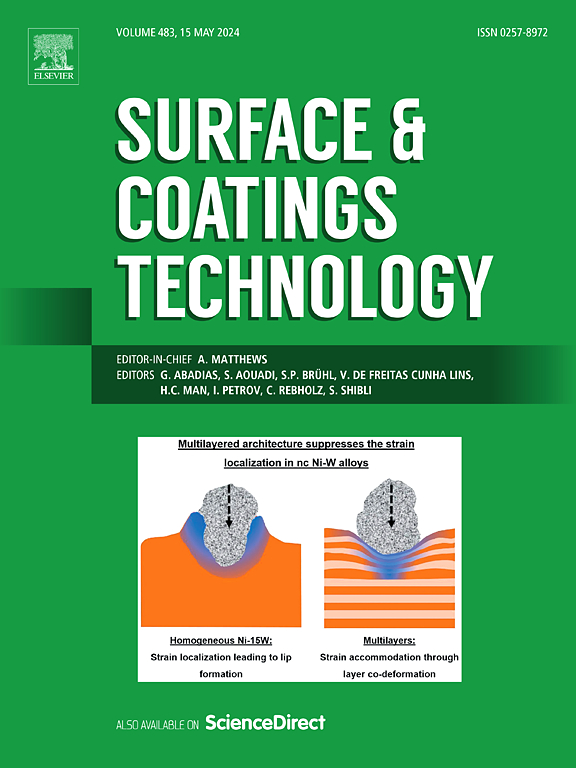Effect of diamond nanoparticles on the performance of PEO coatings on zirconium: Microstructural, mechanical, corrosion, and tribological properties
IF 5.3
2区 材料科学
Q1 MATERIALS SCIENCE, COATINGS & FILMS
引用次数: 0
Abstract
This study investigates the effect of diamond nanoparticle concentrations (0.2, 0.5, and 0.8 g/L) on the performance of PEO coatings on zirconium substrates, focusing on their microstructural, mechanical, corrosion, and tribological properties. The results indicate that diamond nanoparticles filled the coating pores, reducing surface roughness and increasing deposition rates and coating thickness as the concentration increased. Despite these modifications, the phase composition remained unchanged due to the high melting point of the nanoparticles. The coating with 0.5 g/L nanoparticle concentration exhibited the highest hardness (12.64 GPa) and Young's modulus (245 GPa), representing a 405 % increase in hardness compared to pure zirconium. Electrochemical tests showed that the 0.5 g/L sample had the best corrosion resistance, acting as an effective barrier against corrosive agents, with a 99.54 % reduction in corrosion current density compared to pure zirconium. Furthermore, tribological analysis demonstrated improved wear resistance and lower friction, with the 0.5 g/L coating achieving the lowest coefficient of friction of 0.224. Overall, the incorporation of diamond nanoparticles significantly enhanced the corrosion, mechanical, and tribological properties of the coatings, with 0.5 g/L emerging as the most effective concentration based on quantitative results.
本研究探讨了金刚石纳米颗粒浓度(0.2、0.5 和 0.8 g/L)对锆基材上 PEO 涂层性能的影响,重点关注其微观结构、机械、腐蚀和摩擦学特性。结果表明,随着浓度的增加,金刚石纳米颗粒填充了涂层孔隙,降低了表面粗糙度,提高了沉积率和涂层厚度。尽管发生了这些变化,但由于纳米颗粒的熔点较高,相组成保持不变。纳米粒子浓度为 0.5 g/L 的涂层显示出最高的硬度(12.64 GPa)和杨氏模量(245 GPa),与纯锆相比,硬度提高了 405%。电化学测试表明,0.5 克/升的样品具有最佳的耐腐蚀性,能有效阻挡腐蚀介质,与纯锆相比,腐蚀电流密度降低了 99.54%。此外,摩擦学分析表明,涂层的耐磨性提高,摩擦系数降低,0.5 克/升的涂层摩擦系数最低,为 0.224。总之,金刚石纳米颗粒的加入大大增强了涂层的腐蚀、机械和摩擦学性能,根据定量结果,0.5 克/升是最有效的浓度。
本文章由计算机程序翻译,如有差异,请以英文原文为准。
求助全文
约1分钟内获得全文
求助全文
来源期刊

Surface & Coatings Technology
工程技术-材料科学:膜
CiteScore
10.00
自引率
11.10%
发文量
921
审稿时长
19 days
期刊介绍:
Surface and Coatings Technology is an international archival journal publishing scientific papers on significant developments in surface and interface engineering to modify and improve the surface properties of materials for protection in demanding contact conditions or aggressive environments, or for enhanced functional performance. Contributions range from original scientific articles concerned with fundamental and applied aspects of research or direct applications of metallic, inorganic, organic and composite coatings, to invited reviews of current technology in specific areas. Papers submitted to this journal are expected to be in line with the following aspects in processes, and properties/performance:
A. Processes: Physical and chemical vapour deposition techniques, thermal and plasma spraying, surface modification by directed energy techniques such as ion, electron and laser beams, thermo-chemical treatment, wet chemical and electrochemical processes such as plating, sol-gel coating, anodization, plasma electrolytic oxidation, etc., but excluding painting.
B. Properties/performance: friction performance, wear resistance (e.g., abrasion, erosion, fretting, etc), corrosion and oxidation resistance, thermal protection, diffusion resistance, hydrophilicity/hydrophobicity, and properties relevant to smart materials behaviour and enhanced multifunctional performance for environmental, energy and medical applications, but excluding device aspects.
 求助内容:
求助内容: 应助结果提醒方式:
应助结果提醒方式:


